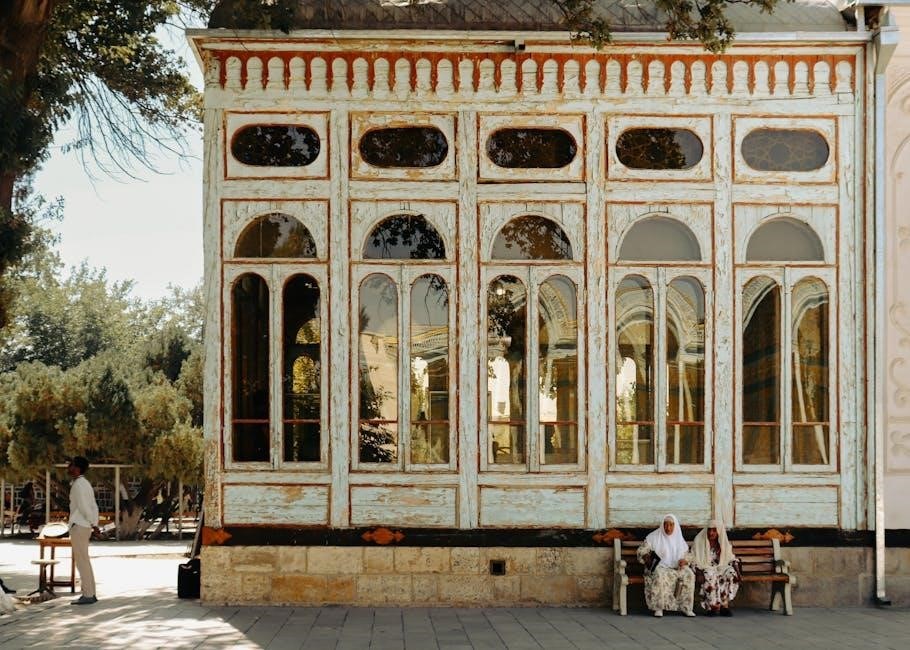Worcester Greenstar 30i ErP Manual: A Comprehensive Guide
This comprehensive guide details the operation, installation, and troubleshooting of the Worcester Greenstar 30i ErP boiler,
covering system problems and essential maintenance procedures for optimal performance.
Understanding the Greenstar 30i ErP Boiler
The Worcester Greenstar 30i ErP is a wall-hung, RSF gas-fired condensing combination boiler designed for both central heating and domestic hot water. It’s part of the Greenstar i System Compact ErP series, known for its efficiency and reliability. Understanding its core functions is crucial for safe and effective operation. This boiler incorporates internal safety systems, and user instructions are readily available for download, covering models from 2014 to 2016, like the Greenstar Ri Compact.
The ErP (Energy-related Products) directive ensures the boiler meets specific efficiency standards. Familiarizing yourself with the boiler’s components and how they interact will aid in troubleshooting basic operating system problems, such as issues with thermostatic radiator valves or reset procedures following alerts. Proper understanding allows for informed maintenance and maximizes the boiler’s lifespan.
Key Features and Specifications
The Worcester Greenstar 30i ErP boasts several key features, including its condensing boiler technology for high efficiency and reduced emissions. It’s a combination boiler, providing both central heating and instant hot water, simplifying installation and space requirements. The boiler is compatible with natural gas and LPG, offering flexibility in fuel source.
Specific specifications include a compact design suitable for various kitchen or utility room settings. While exact dimensions and weight vary, it’s designed for easy wall mounting. Efficiency ratings adhere to ErP compliance standards, ensuring optimal energy performance. User manuals detail operation, and troubleshooting guides address common issues like low pressure or ignition failures. It’s crucial to consult these resources for detailed technical data.

Initial Setup and Installation

Proper installation of the Worcester Greenstar 30i ErP is crucial for safe and efficient operation; it must be performed by a qualified, Gas Safe registered engineer. Initial setup involves securely mounting the boiler to a suitable wall, ensuring adequate ventilation, and connecting to the gas supply, water pipes, and flue system.
The engineer will configure the boiler’s parameters based on your heating system, including setting the central heating flow temperature and hot water delivery rate. Following installation, a thorough system check is essential to verify correct operation and identify any potential issues. Refer to the official installation guide for detailed instructions and safety precautions. Always prioritize gas safety and adhere to building regulations.

Operating Instructions
Understanding the Greenstar 30i ErP’s controls allows for efficient heating and hot water management, including powering on/off, temperature adjustments, and display panel navigation.
Powering On and Off
To power on the Worcester Greenstar 30i ErP boiler, ensure the gas supply is active and the boiler is not in lockout mode. The power switch is typically located on the front panel; toggle it to the ‘on’ position. The display panel will illuminate, initiating the self-check sequence. Allow a brief period for the boiler to complete its diagnostics before attempting to adjust settings.
Shutting down the boiler is equally straightforward. Simply switch the power toggle to the ‘off’ position. The display will darken, and the boiler will cease operation. For extended periods of non-use, it’s advisable to consult the full manual regarding frost protection settings, especially during colder months. Remember that a reset may be needed if alerts persist, indicated by a flashing blue operation/fault light. Always refer to the complete user instructions for detailed guidance and safety precautions.
Setting the Temperature
Adjusting the temperature on your Worcester Greenstar 30i ErP boiler is primarily achieved through the control panel. Utilize the ‘+’ and ‘-’ buttons to increase or decrease the desired central heating and hot water temperatures. The current setpoint is clearly displayed on the LCD screen. Remember to allow sufficient time for the boiler to respond to temperature changes – immediate results aren’t always apparent.
Consider thermostatic radiator valves (TRVs) when setting overall temperatures. If TRVs are set to a low level, they may override the boiler’s settings in individual rooms. Ensure TRVs aren’t hindering heat distribution. For optimal efficiency, avoid excessively high temperature settings; a lower, consistent temperature often provides better comfort and reduces energy consumption. Consult the full manual for advanced programming options and detailed explanations of temperature control features.
Understanding the Display Panel
The Worcester Greenstar 30i ErP boiler’s display panel provides crucial information regarding its operational status. A clear LCD screen showcases the current central heating and hot water temperatures, alongside system pressure readings. The blue operation/fault light indicates normal function or alerts to potential issues via flashing patterns. Error codes, when displayed, require referencing the troubleshooting section of this manual for diagnosis.
Familiarize yourself with the icons representing different modes – heating, hot water, and standby. The panel also displays alerts, such as low-pressure warnings or service reminders. A reset function may be available for minor faults, but persistent issues necessitate professional attention. Regularly checking the display panel allows for proactive monitoring and early detection of potential problems, ensuring efficient and reliable boiler operation.

Troubleshooting Common Issues
This section addresses frequent problems like ignition failures, low pressure, and error codes, offering guidance to resolve them or determine when professional help is needed.
Boiler Not Igniting
If your Greenstar 30i ErP boiler fails to ignite, several factors could be at play. First, ensure the gas supply is active and that all thermostatic radiator valves are set to a high enough position to demand heat. A lack of gas pressure or a closed valve will prevent ignition.
Next, check if the boiler has been reset. Attempt a reset; if unsuccessful, the alert code will reappear, and the operation/fault light will continue flashing. This indicates an underlying issue requiring attention. Internal safety systems within the Greenstar CDi Compact ErP series are designed to shut down operation if faults are detected.

Verify the condensate pipe isn’t blocked, as this can trigger safety shutdowns. If the problem persists, consult a qualified Gas Safe registered engineer for diagnosis and repair. Do not attempt complex repairs yourself.
Low Pressure Problems
Experiencing low pressure on your Worcester Greenstar 30i ErP boiler is a common issue, often indicated on the display panel. Initially, check the pressure gauge; it should ideally sit between 1 and 1.5 bar when cold. If the pressure is consistently low, there may be a water leak somewhere within the central heating system – radiators, pipes, or the boiler itself;

To temporarily resolve the issue, you can repressurise the boiler following the instructions in the user manual. However, this is a short-term fix. Repeatedly needing to repressurise suggests a leak that must be identified and repaired by a qualified heating engineer.
Ignoring low pressure can lead to boiler inefficiency and potential damage. Do not operate the boiler if the pressure is critically low, and always consult a professional for leak detection and repair.
Error Codes and Their Meanings
The Worcester Greenstar 30i ErP boiler utilizes error codes to diagnose potential faults, displayed on the unit’s control panel. These codes provide valuable insight into the problem, aiding in troubleshooting. A flashing blue light often accompanies an error code, indicating a system alert. Common codes include those related to ignition failure, low water pressure, or issues with the flue.
For example, a specific code might signal a problem with the fan, while another could indicate a gas supply issue. Do not attempt to repair the boiler yourself based solely on the error code.
Consult the full user manual or the Worcester Bosch website for a comprehensive list of error codes and their corresponding solutions. If the error persists after a reset, or you are unsure of the meaning, contact a qualified heating engineer for assistance.

Maintenance and Servicing
Regular maintenance, including condensate pipe checks and annual servicing by a qualified engineer, ensures the Greenstar 30i ErP boiler operates safely and efficiently.
Regular Maintenance Tasks
To maintain optimal performance of your Worcester Greenstar 30i ErP boiler, several routine maintenance tasks should be performed regularly by the user. These include visually inspecting the boiler for any leaks or corrosion, ensuring the flue is unobstructed, and checking the condensate pipe for blockages – a common issue, especially during colder months.
Thermostatic radiator valves should be checked to ensure they are functioning correctly and not set too low, potentially causing the boiler to work harder. Regularly check the pressure gauge and top up the system if necessary, following the instructions in the operating manual. It’s also advisable to keep the boiler casing clean and free from dust accumulation.
Remember to address any unusual noises or operational changes promptly. These simple checks can help prevent more significant issues and extend the lifespan of your boiler, ensuring efficient heating and hot water supply.
Annual Servicing Requirements
A yearly service by a qualified Gas Safe registered engineer is crucial for the longevity and safe operation of your Worcester Greenstar 30i ErP boiler. This service goes beyond user maintenance, involving a comprehensive inspection of all gas connections, combustion efficiency, and safety devices.
The engineer will check the flue for proper function, analyze combustion gases to ensure optimal burning, and inspect the heat exchanger for any signs of corrosion. They will also assess the boiler’s internal components, including the fan, pump, and control system.
A service ensures compliance with safety regulations and maintains the boiler’s warranty. Records of servicing should be kept for future reference. Ignoring annual servicing can lead to reduced efficiency, increased risk of faults, and potentially dangerous situations.
Condensate Pipe Maintenance
The condensate pipe, crucial for removing acidic waste from the Greenstar 30i ErP, requires regular attention to prevent blockages. Freezing is a common issue, especially during colder months, potentially causing boiler shutdown. Insulate exposed sections of the pipe to mitigate this risk.
Periodically check the pipe’s exterior for any signs of damage or leaks. Ensure the pipe has a sufficient fall to allow for proper drainage. Avoid obstructing the pipe’s outlet.
If a blockage occurs, do not attempt to clear it yourself; contact a qualified engineer. Improper handling can damage the pipe or boiler. Regular visual inspections and preventative insulation are key to maintaining efficient condensate drainage and avoiding costly repairs.

Safety Information
Prioritize safety with the Greenstar 30i ErP boiler; heed carbon monoxide warnings, gas safety precautions, and understand emergency procedures for secure operation.
Carbon Monoxide Warnings
Carbon monoxide (CO) is a colorless, odorless, and highly poisonous gas, posing a severe health risk. The Greenstar 30i ErP boiler incorporates safety features to minimize CO production, but vigilance is crucial. Ensure a carbon monoxide detector is installed in a central location near the boiler, following manufacturer’s instructions for placement and maintenance.
Regularly test the detector’s functionality to confirm it’s operating correctly. Be aware of the symptoms of CO poisoning, which include headache, dizziness, nausea, breathlessness, and confusion. If anyone experiences these symptoms, immediately evacuate the premises and call emergency services.
Never ignore a CO alarm; treat every alarm as a potential emergency. Do not attempt to diagnose or repair the boiler yourself if a CO alarm sounds. Contact a qualified Gas Safe registered engineer to inspect the boiler and identify the source of the CO. Proper ventilation is also essential; ensure flue pipes are unobstructed and functioning correctly.
Gas Safety Precautions
Working with gas appliances requires strict adherence to safety protocols. Only qualified Gas Safe registered engineers should install, service, or repair the Worcester Greenstar 30i ErP boiler. Never attempt DIY repairs, as improper handling can lead to gas leaks, explosions, or carbon monoxide poisoning.
Regularly check gas connections for leaks using a suitable leak detection fluid – never use a flame. If you smell gas, immediately extinguish any open flames, do not operate electrical switches, and open windows and doors to ventilate the area.
Contact your gas supplier or a Gas Safe registered engineer from a safe location. Ensure the boiler room is well-ventilated to prevent gas accumulation. Do not block or obstruct ventilation openings. Familiarize yourself with the location of the gas shut-off valve and how to operate it in an emergency. Prioritize safety at all times when dealing with gas appliances.
Emergency Procedures
In the event of a boiler malfunction or emergency, swift and decisive action is crucial. If you suspect a gas leak – characterized by a gas smell, hissing sound, or symptoms like dizziness or nausea – immediately shut off the gas supply at the meter. Do not operate any electrical devices, and ventilate the area by opening windows and doors.
If the boiler displays persistent error codes or fails to operate safely, turn it off and contact a Gas Safe registered engineer. Do not attempt to reset the boiler repeatedly if it continues to fault.
Know the location of your carbon monoxide detector and ensure it’s functioning correctly. If the alarm sounds, evacuate the premises immediately and call emergency services. Keep emergency contact numbers readily available. Prioritize personal safety and seek professional assistance promptly in any emergency situation related to your boiler.

Technical Specifications
The Greenstar 30i ErP boasts detailed specifications, including dimensions, weight, gas type compatibility, and crucial ErP compliance efficiency ratings for informed assessment.
Dimensions and Weight
Understanding the physical characteristics of the Worcester Greenstar 30i ErP is crucial for installation planning and ensuring adequate space allocation within the property. Precise dimensions are vital to confirm the boiler will fit comfortably into the designated location, avoiding potential obstructions or accessibility issues during future maintenance.
While specific measurements can vary slightly depending on the exact model iteration, the Greenstar 30i ErP generally features compact dimensions designed for versatile installation options; Typically, the boiler’s height falls around 700mm, its width approximately 400mm, and its depth around 290mm.
Regarding weight, the Greenstar 30i ErP is relatively lightweight, usually weighing between 26 and 30 kilograms. This manageable weight simplifies the handling and mounting process for installers, reducing strain and promoting a safer working environment. Accurate weight information is also essential for structural considerations when wall-mounting the unit.
Gas Type Compatibility
The Worcester Greenstar 30i ErP boiler is engineered for compatibility with both natural gas (G20) and liquefied petroleum gas (LPG, G31), offering flexibility to suit diverse property setups and regional gas supply infrastructures. However, it’s absolutely critical that the boiler is correctly configured for the specific gas type available at the installation site.
Conversion between natural gas and LPG requires a qualified Gas Safe registered engineer to perform a dedicated conversion kit installation and thorough system recalibration. Attempting to operate the boiler on an incompatible gas type can lead to inefficient combustion, increased carbon monoxide production, and potential safety hazards.
The boiler’s internal components, including the gas valve and burner, are specifically calibrated for optimal performance with either G20 or G31. Always verify the gas type setting before initial operation and ensure it matches the property’s gas supply. Incorrect configuration voids the warranty and compromises safety.
Efficiency Ratings (ErP Compliance)
The Worcester Greenstar 30i ErP boiler adheres to the European Energy-related Products (ErP) Directive, demonstrating a commitment to high energy efficiency standards. This compliance is reflected in its impressive efficiency ratings, crucial for reducing energy consumption and lowering heating bills.
The boiler boasts a high seasonal space heating efficiency (ηs) of up to 94%, indicating that 94% of the fuel energy is converted into usable heat. Furthermore, its hot water efficiency (ηwh) reaches up to 86%, ensuring efficient production of domestic hot water.
These ratings are determined through rigorous testing procedures mandated by the ErP Directive, providing consumers with reliable and comparable data. The NOx emissions are also minimized, contributing to a reduced environmental impact. Understanding these ratings allows users to appreciate the boiler’s performance and long-term cost savings.



































